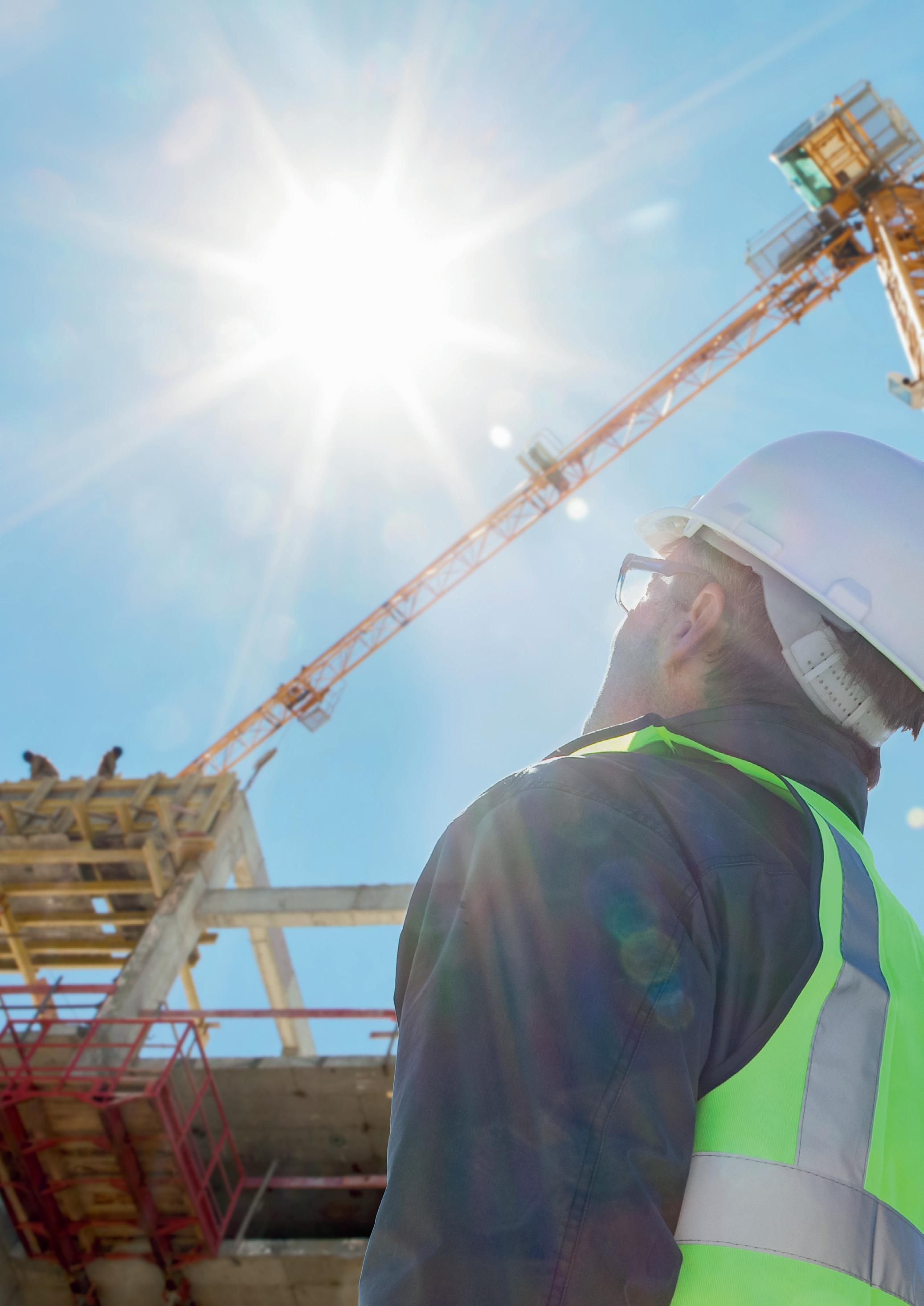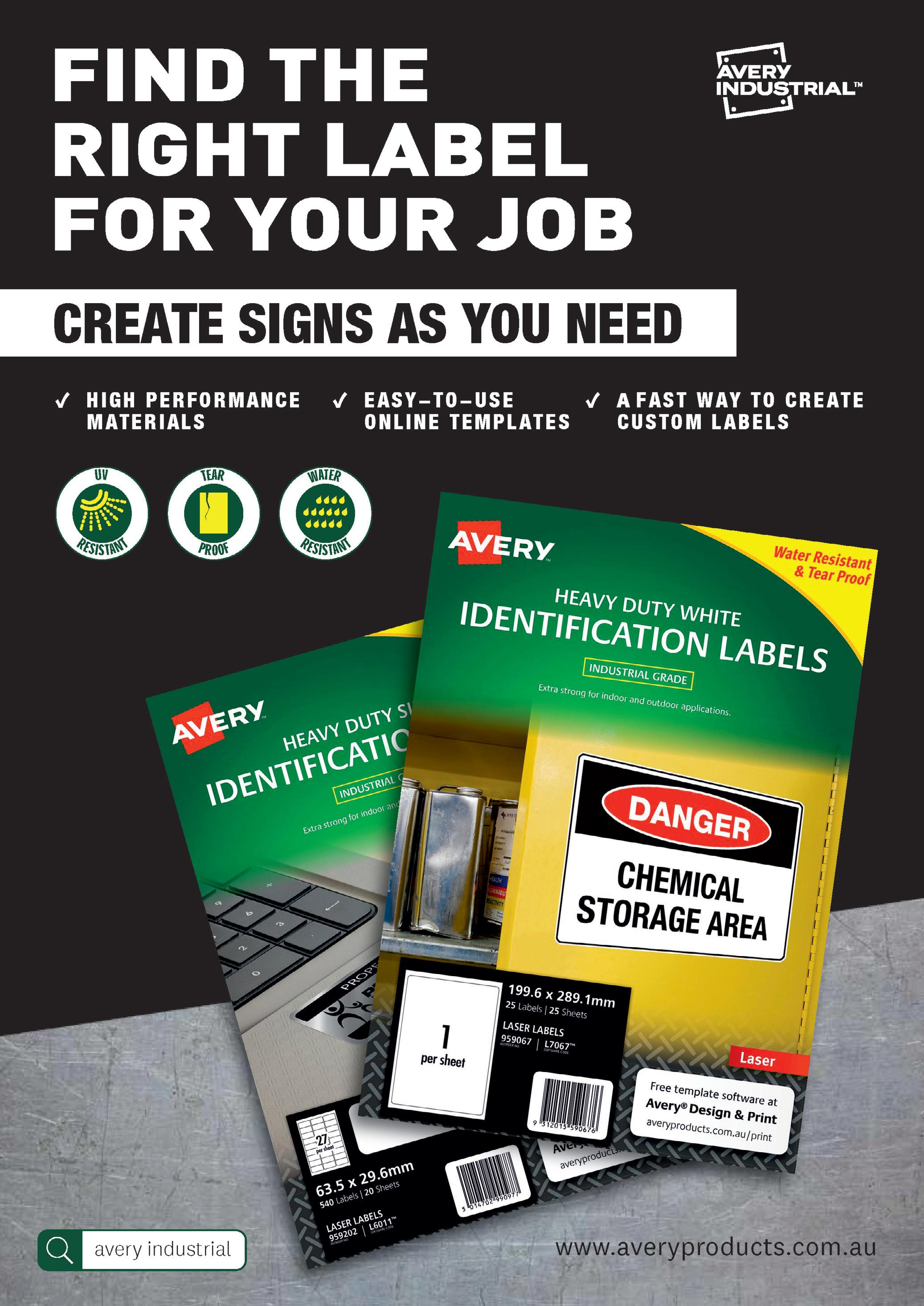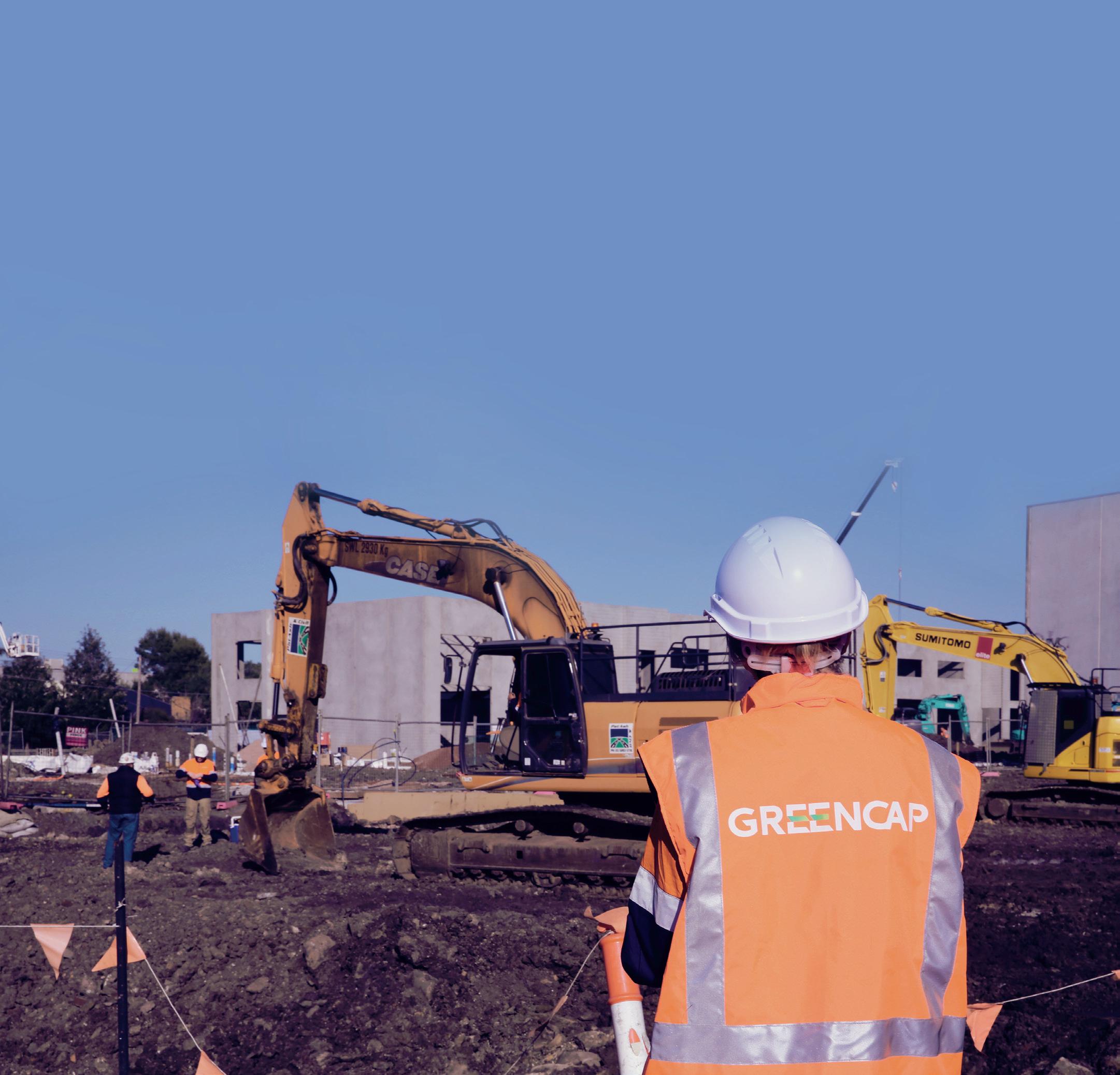
20 minute read
At height — risk assessments, dos & don’ts and fall protection systems
AT HEIGHT
Richard Millar, Chief Executive Officer, Working at Height Association

Working at height remains one of the greatest causes of fatalities and major injuries on Australian worksites, with many workers finding themselves in positions where they are expected to work at height with little or no knowledge of the risks involved. A height safety authority sets out these risks with a focus on the construction industry, explaining the importance of risk assessments and fall protection systems, and offering some key dos and don’ts.
The Australian workforce has many trades that require workers to utilise their skills in the occupation of their choosing, all of whom have been trained in the skills needed to carry out the work required. These workers often find themselves in positions where they are expected to work at height either above or below ground, often with little or no knowledge of the risks they face as there is no legislated requirement other than a recommendation for training in work practice documents for these people to have had at least minimal training in the recognition of risk and the means to minimise those risks and dangers they face when working at height.
Working at height remains one of the largest causes of fatalities and major injuries, and the need to train those who work at height should be paramount among managers, persons conducting a business or undertaking (PCBUs) and others working in these areas of risk. When working at height there are a number of risks and fatality and injury causes that include falls from ladders, through fragile surfaces over edges, and off structures and other assets; in fact, ‘work at height’ means work in any place where, if there were no precautions in place, a person could fall over, fall through or even trip and possibly fall a distance that may cause personal injury or death.
Case study: WorkSafe Victoria 2018 news article
In the article, titled ‘Construction company fined following fall fatality’ (and accessible at www.worksafe.vic.gov.au/news/2018-12/construction-company-fined-following-fallfatality), it is reported that a Melbourne construction company had been convicted and fined $275,000 following the death of a painter who fell 3.46 metres through a stair void at a Mornington Peninsula building site.
The company pleaded guilty in the Melbourne Magistrates’ Court to contravening section 26 of the OHS Act when it failed to ensure that the workplace was safe and without risks to health. The company was ordered to pay $7500 in costs. The news item notes: “A WorkSafe investigation found a wooden handrail at the edge of the first-floor void near where the painter was working had been partially dislodged from one of its clamps.”
When we look at the fall incident in this case we can see that falls are not always about fall arrest equipment that are designed to keep workers safe. Rather, it is really about understanding the risk itself, which can often be easily seen if we take the time to carry out a risk assessment of the work and the workplace.

©stock.adobe.com/au/auremar
Construction
In their document ‘Construction industry profile’, Safe Work Australia has shown that the number of workers in the industry has grown by 33% over the last 11 years and draws together various occupations, which include but are not limited to: • Scaffolders • Painters • Bricklayers • Roofers • Plumbers • Engineers • Builders • Maintenance workers New South Wales In a similar document, SafeWork NSW indicated that in 2010–11, a fall from height accounted for 7730 claims for serious injury. This means that 21 employees each day lodged a claim for a falls-related injury that required one or more weeks off work, and males accounted for three-quarters of the falls-related claims. Within the construction industry, 76% of workers were classed as employees and were covered by workers compensation schemes, and there have been significant reductions in the numbers and rates of injuries and fatalities in this industry over the last 10 years or more. Yet in 2013–14, the construction industry again accounted for 9% of the workforce, but 12% of work-related fatalities. Around 12,600 workers compensation claims are accepted from the construction industry each year for injuries and diseases involving one or more weeks off work. This equates to 35 serious claims each day. In 2012–13, the construction industry had the fourth-highest incidence rate of serious claims per 1000 employees, and had the fifth-highest fatality rate per 100,000 workers in 2013–14.
In NSW, falls from height account for some 35% of injuries and death in construction and mining, though it is interesting to note that this industry is not the most deadly — the transport, postal and warehousing industry heads the list with 38% of the deaths, with SafeWork NSW listing falls from trucks/vehicles as a high risk. Although the regulator has advised that there have been significant reductions in the numbers and rates of injuries and fatalities in the construction industry over the last 10 years or more, height work and falls are still a major cause of death and serious injury (in construction and beyond). This is due to the type of work carried out across a range of industries, including: stacking shelves, working on a roof, unloading a large truck or accessing silos. Falls can also occur at ground level into holes, for example, trenches or service pits.

DOS
DO as much work as you can while you are on the ground. DO make sure that you and others can safely move to and from the area where working at height takes place. DO ensure that the equipment that you’re using for the job is strong, stable and suitable enough to get the job done. Inspect and maintain this equipment regularly. DO be careful when you are working near a fragile surface. DO ensure that you are protected from falling objects. DO make preparations for emergency evacuations and rescues. DO make sure that personal protective equipment (PPE) is in good order and fit for use. DO make sure that you and other at-height workers understand the risk. DO ensure that you and other at-height workers are properly trained.

©stock.adobe.com/au/Tomasz Zajda
DON'TS
DON’T overload the ladders that you are working on, with equipment or materials. DON’T try to reach too far when you’re on a ladder or stepladder. DON’T use ladders or stepladders to do work that entails heavy or strenuous tasks. Only use them to do work that’s quick and light. DON’T allow incompetent workers to do any work at height. DON’T lean or place the ladder on fragile upper surfaces. DON’T stay quiet when you feel someone is compromising their own safety or the safety of others. DON’T use PPE when you cannot confirm its suitability for use.
Fallout
Working at height is high risk and remains one of the biggest causes of fatalities, and we should not lose sight of the seriousness of injuries that can occur and which are ongoing and often life changing. There is an awesome amount of information available on the internet related to working at height, including its risks, injuries, the death rate and responsibilities of the PCBU. We can often find the $ penalties when workers or employers and companies are fined; what we cannot find in the documents are the feelings of devastation and mental cost that workers and companies who have been involved in a fall incur. There are many articles available through the regulators in each of the states and territories on the investigation and resulting outcomes of a fall from height. I have chosen one from WorkSafe Victoria. As a news article it is less complex than others, which helps to show the outcome of an accident and the analysis of the accident by the magistrates’ court.
Work at height risk assessment
could cause harm to those who are to carry out work. It enables you to weigh up whether you have taken enough precautions, or should do more to prevent harm. Employers and employees are required to assess the risks in their workplace so that they can put in place a plan to control those risks. It’s crucial for you to know how to carry out a risk assessment to ensure people can work safely. When creating a work at height risk assessment there are at least 5 key steps: 1. Identifying the hazards. 2. Deciding who might be harmed and how. 3. Evaluating the risks and deciding on precautions. 4. Recording your findings and implementing them. 5. Reviewing your assessment and updating if necessary.
There is a range of resources available online. The Queensland Government’s Department of Education has a working at heights risk assessment template that can be used, for example (accessible at www.education. qld.gov.au/initiativesstrategies/Documents/ working-heights-risk-assessment-template. DOCX). Such resources are designed to assist workplaces in managing fall hazards in the workplace. This includes situations that

©stock.adobe.com/au/Alberto

WE KNOW THAT INJURIES RESULTANT FROM WORKING AT HEIGHT REMAIN
AMONG THE MOST PROMINENT CAUSES OF SERIOUS INJURIES AND FATALITIES.
IN PARTICULAR, FALLS FROM LADDERS, SCAFFOLDING, AND VEHICLES AND STRUCTURES OF ANY TYPE CAN CAUSE SERIOUS INJURY, EVEN WHEN THE HEIGHT IS PERCEIVED TO NOT BE DANGEROUS.
those working in construction are routinely exposed to, such as: • off the ground (eg, up ladders, on work platforms, or on roofs); • on the ground close to deep holes (eg, excavations) edges or ledges (eg, retaining walls); • openings through which people could fall (eg, skylight); or • in areas where objects may fall from higher levels and cause injury.
While having a template to work with is helpful, it is also highly recommended that persons carrying out a risk assessment have training to enable them to understand and recognise the risks that they or workers they are responsible for are faced with, which will better enable relevant persons to put in place appropriate safeguards.
Dos and don’ts
Working at height is considered a high-risk occupation, which normally means that an individual is working in a place that requires necessary precautions to prevent them from falling a distance, resulting in serious injury or death. We know that injuries resultant from working at height remain among the most prominent causes of serious injuries and fatalities. In particular, falls from ladders, scaffolding, and vehicles and structures of any type can cause serious injury, even when the height is perceived to not be dangerous.
Employers and employees need to ensure that they take all measures necessary to lower the risk of falling from a height, and should do so by using pre-emptive hazard recognition and constant site assessment. To restrict the potential for a fall — including but not limited to when preparing work that may require the worker to work at height — there are a number of suggested dos and don’ts. (The dos and don’ts list is a general guide. While useful as a guide on what to look for, it cannot replace the need for training to provide the competence that workers and employers require.)
Fall protection systems
It is said that a tool is most effective when the user knows how to operate it properly, so it can achieve its intended purpose. This point is especially true when that tool is an element of a fall protection system (which may be used in conjunction with the risk assessment of the work to be carried out), since misuse of that equipment can lead to a serious injury or fatality, and costly damage to the equipment itself. Fall protection has historically been a great concern requiring the state and territory regulators to provide a plethora of information, such as: work practice documents, compliance notices, and warning and advice notes. Yet falls continue to be a leading cause of fatalities in Australian industrial workplaces.
Employers can, however, take steps to reduce fall injuries and fatalities by understanding how to properly design, implement and use fall protection systems through quality training of workers and managers. The key to addressing the risks of working at height is to ensure that users have the training and supervision to identify the risks, and that correct equipment and processes are used and understood, so that workers can do their jobs safely. Organisations should strive to avoid putting workers in situations where they need fall protection systems; however, when those cases do arise, they should see that the systems in place are designed, implemented and used correctly. You can find further guidance on proper use of fall protection equipment and developing a fall protection program in Australian Standard AS/NZS1891.4 Care and Use of Industrial Fall Arrest Systems.

CASE
STUDY Report charts factors fuelling global safety gloves’ growth
©stock.adobe.com/au/Kings Access

The rising number of industrial injuries has driven the growth of the global safety gloves market, with 70% of workplace or industrial injuries involving workers who do not wear safety gloves. The remaining people injured used gloves that were either improper or damaged, thereby illustrating the importance of safety gloves and personal protective equipment (PPE). Industrial safety gloves can help protect against hazards such as sharp objects, heat and cold, chemical burns, contact dermatitis, and various communicable diseases. Another compounding factor in a global spike in the safety gloves market came via the coronavirus (COVID-19) pandemic, which has redefined the availability of PPE for the healthcare industry value chain on a global scale.
Safety gloves form an integral part of the medical and healthcare segment, with latex and nitrile gloves used when dealing with high-risk situations involving blood, bodily fluids or patients with infectious diseases. Latex and vinyl gloves can also be used for lowrisk general procedures such as non-invasive physical exams. On the back of these factors, the safety gloves market is predicted to reach a value of US$19 billion by 2030, according to a report from Persistence Market Research. The report estimates that the safety gloves market will register a compound annual growth rate of more than 6% during the forecast period of 2020–2030. By product type, durable safety gloves accounted for a larger share in the global safety gloves market compared to disposable safety gloves.
COVID-19 has also resulted in a spike in the need for hand hygiene, with community programs spreading awareness among people about adequate health and hygiene practices that must be conducted. Growing consumer awareness has resulted in increasing demand in the safety gloves market landscape. Demand for surgical safety gloves and sterile safety gloves, both declining within the disposable safety gloves market, experienced a steep rise since the first quarter of 2020, and is predicted to drive sales in the overall safety gloves market till the first quarter of 2021. An overview of the changing landscape of the global safety gloves market has led the report’s analysts to conclude that the market is gaining momentum, largely fuelled by the COVID-19 pandemic.
Amid the outbreak of the COVID-19 pandemic, a majority of manufacturers in the safety gloves market increased their production capacities to bridge the supply–demand gap. However, complete lockdowns, total shutdown of all industries and havoc in the industrial space all resulted in a decrease in initial production during the pandemic. In response, manufacturers increased production, catering to rising global demand for safety gloves. Although the lockdowns stalled industrial operations for a period, the demand for safety gloves from the manufacturing sector is predicted to gain prominence over the forecast period. Further, recent operations have seen a surge in general hygiene and sanitation practices by consumers worldwide, which is predicted to drive the global safety gloves market. Competition among the market players has also witnessed a rise, due to the increase in the market’s growth trajectory.
The report also found that the global safety gloves market represents a fragmented competitive landscape, where a majority of key players maintain their strategic focus on the pricing strategy, product strategy, digital advertising of products and remodelling of the supply chain network. A majority of the safety gloves market is dominated by a few major players, the report notes, such as 3M, Ansell, Avon Rubber, Cofra, Adhesive & Equipment, Amada Miyachi America, Mallcom, Lakeland Industries, Delta Plus, Superior Glove Works, Globus Group, Midas Safety and Hartalega Holdings Berhad, among others. The report identified North America as the largest market for safety gloves in 2019, followed by Europe. Globally, food safety is finding momentum, with the implementation of good manufacturing practices and overall hygiene across the food service industry, thus further increasing demand for safety gloves and resulting in higher sales across the world.
Persistence Market Research
www.persistencemarketresearch.com


CASE
STUDY Shutdown solution lifts safe forklift handling in prison
Image credit: RCT

Smart technology specialist RCT in Brisbane has worked with Toyota Material Handling Australia (TMHA) to customise a Toyota 8FG25 Forklift that provides appropriate and supervised control of forklift operations within a prison on the east coast of Australia. RCT technicians designed a technology package consisting of a ControlMaster remote shutdown solution installed on the forklift and linked to a handheld transmitter. The system is designed so that the site supervisor must use the handheld transmitter to engage the forklift, after which trained and certified machine operators can use the forklift. The technology package is designed to automatically shut down the forklift if it is more than 200 metres away from the handheld transmitter or if any part of the solution is interfered with.
RCT Account Manager (Industrial) Nicholas Noorman said the project ensures all machine operators can use the forklift in an appropriate and safe manner in line with prison guidelines. “We have received very positive feedback from prison authorities and from THMA and look forward to providing ongoing technical support in the future,” Noorman said. “This technology package can quite easily be applied to other scenarios, such as forklift driver training courses, to better equip and supervise a workforce.” The solution is another addition to the RCT industrial product range, which includes fleet management systems, safety products and electrical spare parts.
RCT
www.rct-global.com
Practical assessments
When it comes to practical assessments in the field, paper-based forms and manual processes are still a widely used practice. While the assessment forms themselves have been created ‘digitally’ as Word or PDF documents, their usage is still very manual.
With INX Assessor, training administrators can leverage the form template designer capability to create and manage a library of assessment forms for assessors to conduct and record practical assessments. These forms will be available to assessors for use on iOS and Android devices, to complete in the field, in online or offline mode. As part of in-built workflows, all completed assessments will be routed to a site manager for approval and will be stored in a central administrative portal.
With INX Assessor, all field assessors can now reduce the time spent on administrative tasks such as scanning and filing paper forms and reduce the risks of forms lost or misplaced. With an entire digital process, not only are assessors using systems which are faster and safer, but the data is stored in real time for historical compliance and a simple audit trail.
INX Assessor streamlines efforts for other on-flow tasks. Training administrators have a consolidated view and improved visibility of all assessments throughout the business with the centralised web portal. Once approved, the seamless integration with INX InTuition will automatically update the trainee’s profile, ultimately reducing the cost and potential risks of non-compliance.
INX Software Pty Ltd
www.inxsoftware.com


Klaus Huber, Product Manager and Design Engineer, BalTec
PLAYING IT SAFE: SWISS DESIGN ENGINEERS CHOOSE SICK SAFETY SOLUTIONS

The machine builder BalTec has developed a novel electrical riveting machine. The previously pneumatic drive has been replaced with servomotors, which make the connection technology much more effi cient and fast. This machine from BalTec is setting a new benchmark in the industry. When searching for the best partner for safety devices during the exciting development process, SICK was the obvious choice.
Klaus Huber is a mechanical engineer and individualist who likes to tread his own path but with a clear goal in mind: “In the end, it simply has to be ‘very good’!” He started developing the electrically driven riveting machine in November 2015 as a product manager at the mid-sized BalTec Group. After four years of intensive work, the “Electric” product family with its two mechanical sizes reached market readiness for a total of four different force ranges. BalTec produces machines for connection technology and is the global leader in technologies for radial and wobble riveting as well as rolling and pressing. Domenico Mollo, Managing Director at BalTec, added: “We want to differentiate ourselves in the market and always fi nd the best solution for the very specific requirements of each of our international clients. Equipping our machines with the best possible safety concept is absolutely essential to us.”
Driver of sustainability
BalTec did not shy away from starting the costly and lengthy process of developing a servo controlled riveting machine. “As a rule, machines are strictly tied to one process technology with a relatively narrow processing window, but now the three classical forming processes — radial, orbital and roller — can be employed in one compact machine because the servo technology allows us to freely select and specify all kinematic parameters, including the infeed rate and speed of rotation,” explains Huber in regards to the design advantages of the “Electric”. For users, this means they can replace up to three pneumatic machines with a single electrical one and quickly amortize the higher investment cost through greater effi ciency, higher speeds, and perfect precision.
When it comes to machine safety, the Swiss mechanical engineers were not willing to make any compromises. BalTec set itself the goal of achieving the highest performance level e (EN ISO 13849). They therefore chose to use the deTec4 core light curtain, the STR1 transponder safety switch, and the TR10 Lock safety locking device from SICK. “Using these three systems for access protection, we were able to implement the highest standard of safety for every variant of the ‘Electric’, all from a single source,” says Huber. The absence of blind zones, in particular, is what impressed him the most about the deTec4 core: “It enables me to successfully integrate the device into the overall concept and I consider it a great feature.” He also praises the design feature of the deTec product family whereby the protective fi eld height can be set in increments of 150 millimeters between 300 and 2,100 mm: “That was well thought out!” The short response time provided more design freedom because it allowed the light curtain to be positioned close to the machine and an ergonomically satisfying workspace to be designed.
Short response times and successful design
With short safety times of just 40 ms response time, 100 ms release time and 80 ms risk time, the STR1 non-contact safety switch has also been incorporated into the “Electric” with sliding table. It ensures a high machine availability thanks to a large door offset tolerance. The compact design again offers fl exibility in mounting. Furthermore, the high coding level of the actuator fulfi lls the requirements of EN ISO 14119 on manipulation protection without additional measures.
Good future prospects with the “Safety Assistant” app
BalTec offers its own Human Machine Interface (HMI) dashboards for setting up the machine and supports its customers with a training session on the function of this interface. That SICK already offers apps for on-site diagnostics via smartphone for this NFC technology is of great interest to the Swiss machine builder in this regard and puts Klaus Huber at ease: “It’s good to know they already have that in their portfolio and I don’t have to go looking for a new supplier again.”





